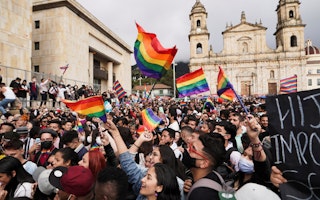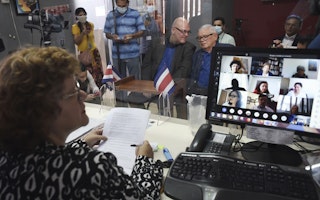Q&A: A Media Haven for Europe’s LGBTI Roma

In 2018, Open Society Foundations Community Youth Fellow Laszlo Farkas started his own queer Roma television station. Recently, Open Society’s Zachary Turk spoke with Farkas about QRTV and his plans for the future.
You recently launched an independent multimedia platform called Queer Roma TV (QRTV). Tell us more about it?
QRTV’s main goal as a digital TV station is to provide greater visibility to members of the queer Roma community and to bring marginalized people together. Our hope is that by doing this, we’ll show people how much diversity and complexity there is within these communities, which are often and mistakenly seen as monolithic.
What inspired you to create QRTV?
I was working as a DJ in Budapest under the name gypsyrobot.tv and loved it. But in 2014, after the Hungarian LGBTI rights activist Milan Rozsa took his own life, I asked myself: Who else is going to stand out for our equal rights and against the prejudices and racism we face, if not us? That’s when I decided to become an advocate for the Roma LGBTI community.
I also had experience working at a Hungarian commercial television channel (which later became part of the Hungarian government’s propaganda machine). It encouraged me to think about the creation of new media platforms and their potential as an independent information source.
Why is it important for there to be more variety and diversity when it comes to media depictions of Roma—and Roma LGBTI—people?
First of all, in general, international human rights communities and media have not taken this issue seriously enough—and this is really unfortunate, because the ways Roma LGBTI people are presented in the media (when they’re presented at all) are often really degrading and harmful.
Since the mid-2000s, in Hungary, for example, Roma LGBTI people have mainly been seen on Jerry Springer–style sensationalist and exploitative afternoon shows in which they’re depicted basically as objects of ridicule and disgust. And I believe these presentations have a harmful influence on Roma LGBTI people, because they make it harder for us to resist internalizing these stereotypes and humiliations.
What is QRTV doing—or planning to do—to push back against these media-perpetuated stereotypes and biases?
While we have only been on air for a few months, QRTV has interviewed and reported on Roma and LGBTI issues across Europe—from interviewing Roma World War II survivors in Ukraine to organizing a photo exhibition in Brussels about how Roma LGBTI people have contributed to the history of art and activism in Europe.
We also have plans to launch a music channel soon, which we’re hoping will broadcast music from Roma LGBTI artists who are underrepresented in the mainstream music industry.
What do you hope to ultimately accomplish with QRTV?
My main wish is for there to be more happy, out, and proud queer Roma people all around the world.
Our community is so often marginalized or discriminated against, and I think it is essential to have a safe online space for queer Roma people, where they can be themselves and take pride in who they are and benefit from a sense of being part of a supportive, decent community. I hope QRTV can be that for people.


